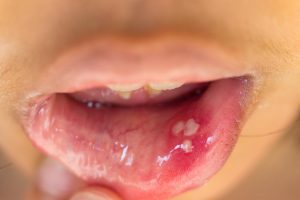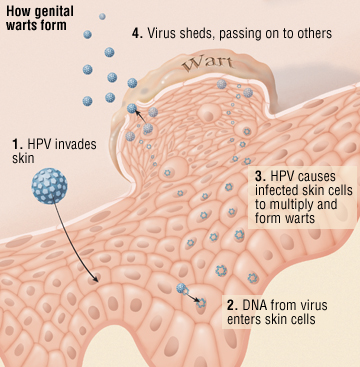HPV- Human Papillomavirus
Human papillomavirus, known as HPV, is a classification that includes over 150 different viruses. In order to differentiate between these related viruses, each is given its own HPV type, which is an assigned number. Each type falls into one of two categories: low-risk HPV and high-risk HPV. While HPV is the most prevalent sexually transmitted disease (STD), it’s readily spread through non-sexual contact. There are certain types of HPV that the body is able to eradicate on its own, others carry long-term serious health consequences. Symptoms and side effects vary drastically from undetectable to cancer causing. There isn’t a cure for HPV, however preventative measures, including vaccines exist.

Human Papillomavirus
Source: livescience.com
Human papillomavirus is a single name given to describe a large number of differing viruses. The name originated to describe the papillomas, or skin lesions, that are commonly associated with several of the HPV types. Low-risk HPVs describe HPV types that do not lead to cancer and are mostly self-resolving. They often manifest papillomas or warts on the feet, hand, anus, and repository tract, according to cancer.gov. Types 6 and 11 can lead to genital warts. High-risk HPVs describe at least twelve HPV types that do potentially lead to cancer (type 16 and 18 account for most incidents), although most are also self-resolving. Non-resolving, high-risk types, according to cancer.gov, “can lead to cervical cancer, cancers of the anus, vagina, vulva, penis, and oropharynx.” In total, “approximately 70% of HPV infections resolve spontaneously in 1 year and 90% in 2 years, while HPV persistence develops in the remainder,” reports science direct.com.
Table 1. HPV types associated with particular diseases (adapted from several sources).
| Disease | Most frequently associated HPV types | |
|---|---|---|
| Common warts | HPV 2, 4, 7; occasionally other types in immunosuppressed (e.g. HPV 75–77) | |
| Flat plane warts | HPV 3, 10, occasionally HPV 26–29 and 41 | |
| Plantar warts | HPV 1, 2, 4 | |
| Epidermodysplasia verruciformis | Plane warts | HPV 3, 10 |
| Pityriasis-like plaques | HPV 5, 8; less commonly 9, 12, 14, 15, 17, 19, 20, 21–25, 36–39, 47, 49 | |
| Squamous cell carcinomas of sun-exposed skin | HPV 5, 8, less commonly 14, 17, 20 and 47 | |
| Anogenital warts | External warts | HPV 6, 11, 40, 42, 43, 44, 54, 61, 72, 81, 89 |
| Buschke–Lowenstein tumour | HPV 6 | |
| Bowenoid papulosis | HPV 16, 55 | |
| Anogenital cancers and precancers | Group 1: Carcinogenic to humans | HPV 16, 18, 31, 33, 45, 51, 52 |
| Group 2A: Probably carcinogenic to humans | HPV 68 | |
| Group 2B: Possibly carcinogenic to humans | HPV 26, 53, 64, 65, 66, 67, 69, 70, 73, 82 | |
| Oral lesions | Oral papillomas | HPV 2, 6, 7, 11, 16, 18, 32, 57 |
| Laryngeal papillomas | HPV 6, 11 | |
| Focal hyperplasia (Heck’s disease) | HPV 13, 32 | |
| Oropharyngeal carcinoma | HPV 16 predominantly, 18 |
Table Source: sciencedirect.com
(Numbers in bold and italics were added for emphasis to highlight types listed in the text.)
Breakdown of Cancers Associated with HPV by Sex
Source: uwsp.edu

HPV’s large range of viruses have large reaching effects. There are roughly 80 million people in the United States who are currently infected with HPV with an additional 14 million newly infected a year, according to NYU Langone Health. In fact, most people will get some type of HPV in their lifetime. HPV can be transmitted sexually (vaginal, anal, and oral), by skin-to-skin contact, and less commonly from mother to child in utero or during birth. The majority of cases will likely show no or little in the way of symptoms and differ among type and location. Oral symptoms include, but aren’t limited to, lumps, lesions, or sores that persist for three or more weeks, chronic cough, sore throat, or hoarseness, or discoloration. In the genital region there can be itching, burning, bleeding, small or large bumps that are raised or flat.

HPV in the Mouth
Source: medicalnewstoday.com

How Genital Warts Form
Source: health.harvard.edu
There are multiple ways to prevent, detect, and treat HPV. The Centers for Disease Control and Prevention now recommends vaccination for all adolescents as early as age nine, optimally between ages 11 and 12, against HPV. A vaccine regiment of Gardasil® or Cervarix® is advised for females up to age 26 and males through age 21. These vaccines are not exhaustive in their protective abilities against all strains of HPV, they narrowly target those that most prominently contribute to genital warts, cervical, and other cancers. Prevention of the sexual spread of HPV is a key to prevention, infected individuals often don’t know that they are carrying and can spread HPV since it is so often asymptomatic. The use of condoms, limiting of sexual partners, and avoidance of risky sexual practices offers the best, but still incomplete, protection. Doctors and oral health professionals can sometimes detect physical symptoms when growths are present and women can be tested in conjunction with their annual pap test or be given a HPV test in order to diagnose it. While HPV itself cannot be treated, the conditions that manifest from it (cervical cancer, warts, cancers of the head and neck) can be treated to varying degrees. Boosting the immune system with a nutrient rich diet helps the body to suppress and fight HPV.
References:
“70% of Americans Infected With HPV”; livescience.com;
“Diseases Associated With Human Papillomavirus Infection”; sciencedirect.com;
“HPV and HPV Testing”; cancer.org;
“Human Papillomavirus (HPV)”; cdc.gov;
“Human Papilloma Virus (HPV)”; health.harvard.edu;
“Medical Definition of Virus”; medicinenet.com;
“NCI Dictionary of Cancer Terms”; cancer.gov;
“Oropharyngeal Cancer Treatment (Adult) (PDQ)- Patient Version”; cancer.gov;
“Should I Worry About a Papilloma?”; medicalnewstoday.com;
“Types of Human Papillamavirus”; nyulangone.org;
“Understanding Sexually Transmitted Diseases (STDs)”; webmd.com;
“Vaccine”; dictionary.com;
“Vaccines, Blood, and Biologics”; fda.gov;
“What Does HPV Look Like in You Mouth?”; medicalnewstoday.com;
“What is Cancer”; cancer.gov;
“What is HPV?”; uwsp.edu;